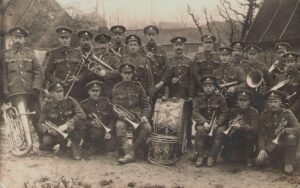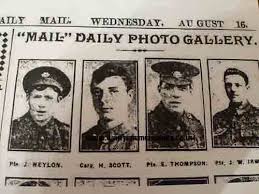The 1/4th Battalion of the East Yorkshire Regiment (T.F.) was raised in 1858 and was known for many years as the “Hull Rifles” and later as the “Fighting Fourth”.
After having various titles, as the volunteer system of the home defence developed, it became the Territorial Force in 1908, based at Londesborough Barracks, Hull. Under this scheme it became a unit of the York and Durham Infantry Brigade, Northumbrian Division, afterwards known as the 150th. Infantry Brigade, 50th. Division. Companies, A, B, C, D, E and F were located in Hull, G and H in East Hull.

On August 4, 1914, the battalion, commanded by Lieut-Col. G.H.Shaw V.D., was mobilised at Hull, and proceeded to its first war station in Holderness. Shortly afterwards it was moved to Darlington to defend a wireless station at Stockton on Tees, and then to Newcastle to prepare for overseas action. Over 75% of men volunteered for service abroad at the first time of asking. It embarked for France on April 17, 1915.
They landed at Boulogne France on 17th April 1915. On April 18, it entrained for Cassel, and then, on April 19, marched to the Steenvoorde area.
In the hamlet of Gravenstafel about 5:00 p.m. on 22 April, the Germans released 168 long tons (171 t) of chlorine gas over a 6.5 km (4.0 mi) front on the line held by French Territorial troops in the path of the gas cloud sustained about 6,000 casualties. Many died within ten minutes and others were blinded.
The 1/4th East Yorkshire battalion was “stood to arms” on April 22, and proceeded by “bus” to Vlamertinghe on April 23rd to stop the German advance.
On the morning of 24 April, the Germans released another gas cloud towards the re-formed Canadian line just west of St. Julien. The village of St. Julien was in the rear of the 1st Canadian Division until the poison-gas attack of 22 April, when it became the front line. Word was passed to the troops to urinate on their handkerchiefs and place them over their nose and mouth. The countermeasures were insufficient, and German troops took the village. The next day the York and Durham Brigade units of the Northumberland Division counter-attacked, failing to secure their objectives but establishing a new line closer to the village. On 26 April 4, 6 and 7 Battalions, the Northumberland Brigade, the first Territorial brigade to go into action, attacked and gained a foothold in the village, but were forced back, having suffered 1,954 casualties.
The next day the men of the 1/4th East Yorkshire Battalion marched to the Yser Canal, and at 4 pm., from the chateau of Potijze, the whole brigade counter-attacked towards Fortuin, and through very heavy gun-fire drove the enemy back into St. Julien.
This counter-attack was carried out perfectly, and was successful, but at great cost. Hull casualties being very heavy both amongst officers and men.
The gallant commanding officer, Lieut-Col. George H. Shaw, V.D., was killed early in the engagement. The object, however, had been achieved, and the brigade received special thanks from General Plummer. The battalion was then commanded by Major (now Lieut-Col.) Arthur Easton, who, being twice wounded in the next few days, was followed by Capt. (now Lieut-Col.) W.T. Wilkinson D.S.O. When the battalion was taken out of the line on May 4th, 1915, it had only some eight officers, and had lost more than half its strength.
The Battle of St. Julien (2nd Battle of Ypres 24 April 1915 to 4 May 1915)
In April 1915 the weather in Ypres, Belgium was cold, wet and thoroughly miserable. The last week of that month saw a ferocious battle for possession of the town which has become known as the Second Battle of Ypres. It was fought at four separate locations including the little village of St. Julien. This was a village which was held at the beginning of the battle by Canadian and French troops. At St. Julien the battle raged between 24 April 1915 and the 5 May 1915. It was a battle which saw the first German use of gas as a weapon of war and the Allied soldiers that fought in it did so fighting not only the weather, the gas, but also constant machine gun and artillery fire.

It was into this battle that the East Yorkshire Regiment was thrust despite having only arrived in Belgium on 17 April 1915. Amongst their number was their Second in Command, a 33 year old Captain called Bede Farrell and his younger brother Adrian. Both were the sons of Thomas Farrell, a Partner in this firm (then known as “Rollit & Co”). Bede, himself, had been an Articled Clerk and later a Partner in this firm between 1910 until late 1913 when he left and formed his own firm. It was a short lived venture as within a year he closed it down to volunteer for the Regular Army (he had been a Territorial Army Officer since 1900 when he was 19). In April 1915 Bede was Second in Command of a battalion of 229 men (including his brother) of the East Yorkshire Regiment.
Upon their arrival in Belgium the East Yorkshires were to be stationed at what were, until 24 April 1915, reserve trenches at the village of St. Julien. On 23 April 1915 Bede’s battalion spent the evening trying to get some sleep in huts about one and a half miles from Ypres. Sleep, however, is difficult when it is freezing cold and artillery shells are exploding all around you. In any event their sleep was interrupted at 2.00 am on the morning of 24 April 1915 when they received the order to go forward to the reserve trenches at the village of St. Julien. Upon their arrival (at about 3.15 am) they were ordered to dig themselves in. This involved each man digging a hole deep enough to stand in and then digging sideways to join up with holes dug by their mates. In this way a trench was created. This task was undertaken in the terrifying circumstances of shrapnel exploding only a few yards away.
Luck was certainly not with Bede’s battalion as it was this day the Germans decided to launch an attack on the village of St. Julien beginning with a gas attack and following it up with ferocious artillery and machine gun fire.
At 10.30 that morning Bede’s battalion was ordered to leave its recently dug trench and advance and again dig themselves another trench. Having done so they then spent that day avoiding the shrapnel which was exploding all around them. At 4.00 o’clock in the afternoon Bede’s battalion got its order to “go over the top” and attack the Germans. Despite knowing the chances of survival or avoiding serious injury were slim Bede and the rest of his battalion went “over the top” and attacked the Germans facing up to terrific artillery and machine gun fire. As might be anticipated the battalion suffered heavy losses with many men killed and wounded. Sadly amongst those killed was Bede who was reported to have been shot in the heart as he led his men towards the German lines. Tragically also a little over a week later on 3 May 1915 his younger brother Adrian was also badly wounded. Whilst he survived the battle he died of his wounds a year later.
Among the Hull Casualties were Officers – Lieut-Colonel G H Shaw, in command, Major A Easton, Captains H J Gosschalk, B Farrell, A Sissons, P Robson, T J Morrill, A B Quibell, Captain and Adjutant W T Wilkinson, D.S.O., and Lieut and Quartermaster F W Cook.
The efforts of the East Yorkshire Regiment and the other Allied troops involved in the battle were not in vain as they helped not only rescue Canadian and French soldiers who occupying the front line had been the first to face the German bombardment of gas and artillery, they also successfully defended the town of Ypres which remained in control of the Allies.
Bede has no known grave and is remembered only by the inscription of his name on the Menin Gate War Memorial.
Our firm will this year celebrate its 175th birthday. In doing so we should not forget that the last 100 years of our firm’s existence and ability to practice law to serve the people and businesses of Hull, East and North Yorkshire and beyond was bought by the courage and sacrifice of thousands of soldiers like Bede Farrell, his brother Adrian and, of course, parents such as this firm’s partner Thomas Farrell and his wife.

1/4th Battalion Territorial Force
04.08.1914 Stationed at Hull as part of the York & Durham Brigade of the Northumbrian Division and then moved to South Holderness and then on to Darlington and then Newcastle.
07.04.1915 Mobilised for war and landed at Boulogne where the formation became the 150th Brigade of the 50th Division which engaged in various action on the Western Front including;
During 1915 – The Battle of St Julien, The Battle of Frezenburg Ridge, The Battle of Bellewaarde Ridge.
During 1916 – The Battle of Flers-Courcelette, The Battle of Morval, The Battle of the Transloy Ridges.
During 1917 – The First and Second Battles of the Scarpe, The Capture of Wancourt Ridge, The Second Battle of Passchendaele.
During 1918 – The Battle of St Quentin, The Actions at the Somme Crossings, The Battle of Rosieres, The Battle of Estaires, The Battle of Hazebrouck, The Battle of the Aisne.
15.07.1918 Reduced to cadre and moved to defend the Lines of Communication in Dieppe. Training American Troops
16.08.1918 Transferred to the 116th Brigade of the 39th Division.
07.11.1918 Demobilised at Cucq.
Of the 939 soldiers of the 4th East Yorkshires, landing in April 1915, only 6 soldiers (No Officers), were serving with the 1/4th regiment at the end of the war. The Commonwealth War Graves Commission records 1.061 ww1 deaths for the 4th East Yorkshire, of which 489 came from Hull and the East Riding. This figure includes records for the 1st/4th, 2nd/4th (Formed at Darlington, September 1914. February 1915 : attached to 189th Brigade, 63rd Division, which was broken up in July 1916, moved in November 1916 to Bermuda, remaining there throughout the war) and 3rd/4th Battalions (Formed in Hull, March 1915, and remained in UK throughout the war)